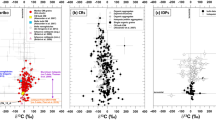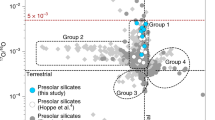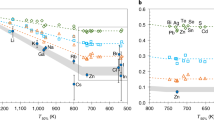Abstract
THE nature and distribution of interstellar grains in meteorites reflect both the material inherited from the Sun's parent molecular cloud and processes that operated in the early Solar System. The discovery of interstellar diamond and silicon carbide (SiC) in carbonaceous chondrites1,2 demonstrated that presolar grains were incorporated into at least some meteorites. Here I show that interstellar diamond and SiC were incorporated into all chondrite groups. Abundances rapidly go to zero with increasing metamor-phic grade (with diamond typically surviving better than SiC), suggesting that metamorphic destruction is responsible for the apparent absence of these grains in most chondrites. In unmetamor-phosed chondrites, abundances normalized to matrix content are similar for different classes (500–1,000 p.p.m. for diamond; 10–18 p.p.m. for SiC). Diamond samples from chondrites of different classes have remarkably similar noble-gas contents and isotopic compositions, although constituent diamonds may have come from many sources. SiC seems to be more diverse, in part because grains are large enough to measure individually, but average characteristics seem to be similar from meteorite to meteorite. These observations suggest that various classes of chondritic meteorites sampled the same Solar-System-wide reservoir of interstellar grains.
This is a preview of subscription content, access via your institution
Access options
Subscribe to this journal
Receive 51 print issues and online access
$199.00 per year
only $3.90 per issue
Buy this article
- Purchase on Springer Link
- Instant access to full article PDF
Prices may be subject to local taxes which are calculated during checkout
Similar content being viewed by others
References
Lewis, R. S., Tang Ming, Wacker, J. F., Anders, E. & Steel, E. Nature 326, 160–162 (1987).
Tang Ming & Anders, E. Geochim. cosmochim. Acta 52, 1235–1244 (1988).
Lewis, R. S. & Anders, E. Lunar planet Sci. 19, 679–680 (1988).
Tang Ming & Anders, E. Geochim. cosmochim. Acta 52, 1245–1254 (1988).
Zinner, E., Tang Ming & Anders, E. Geochim. cosmochim. Acta 53, 3273–3290 (1989).
Huss, G. R. & Lewis, R. S. Meteoritics 24, 278–279 (1989).
Huss, G. R. & Lewis, R. S. Lunar planet. Sci. 21, 542–543 (1990).
Alexander, C. M. O'D., Arden, J. W., Pier, J., Walker, R. M. & Pillinger, C. T. Lunar planet. Sci. 21, 9–10 (1990).
Stone, J., Hutcheon, I. D., Epstein, S. & Wasserburg, G. J. Lunar planet. Sci. 21, 1212–1213 (1990).
Amari, S. & Lewis, R. S. Meteoritics 24, 247–248 (1989).
Huss, G. R., Taylor, G. J. & Keil, K. Geochim. cosmochim. Acta 45, 33–51 (1981).
McSween, H. Y. Geochim. cosmochim. Acta 41, 477–491 (1977).
McSween, H. Y. Geochim. cosmochim. Acta 41, 1777–1790 (1977).
McSween, H. Y. Geochim. cosmochim. Acta 43, 1761–1770 (1979).
Larimer, J. W. & Anders, E. Geochim. cosmochim. Acta 31, 1239–1270 (1967).
Anders, E. & Grevesse, N. Geochim. cosmochim. Acta 53, 197–214 (1989).
Peck, J. A. Lunar planet. Sci. 14, 598–599 (1983).
Huss, G. R. Earth Moon Planet. 40, 165–211 (1988).
Schelhaas, N., Ott, U. & Begemann, F. Geochim. cosmochim. Acta (in the press).
Alexander, C. M. O'D. et al. Meteoritics 24, 247 (1989).
Alaerts, L., Lewis, R. S. & Anders, E. Geochim. cosmochim. Acta 43, 1399–1415 (1979).
Moniot, R. K. Geochim. cosmochim. Acta 44, 253–271 (1980).
Alaerts, L., Lewis, R. S., Matsuda, J. & Anders, E. Geochim. cosmochim. Acta 44, 189–209 (1980).
Alaerts, L., Lewis, R. S. & Anders, E. Geochim. cosmochim. Acta 43, 1421–1432 (1979).
Matsuda, J., Lewis, R. S., Takahashi, H. & Anders, E. Geochim. cosmochim. Acta 44, 1861–1874 (1980).
Sears, D. W., Grossman, J. N., Melcher, C. L., Ross, L. M. & Mills, A. A., Nature 287, 791–795 (1980).
Sears, D. W. G. & Hasan, F. A. Surv. Geophys. 9, 43–97 (1987).
Scott, E. R. D. & Jones, R. H. Meteoritics 24, 324–325 (1989).
Christophe-Michel-Levy, M. Earth planet. Sci. Lett. 30, 143–150 (1976).
Author information
Authors and Affiliations
Rights and permissions
About this article
Cite this article
Huss, G. Ubiquitous interstellar diamond and SiC in primitive chondrites: abundances reflect metamorphism. Nature 347, 159–162 (1990). https://doi.org/10.1038/347159a0
Received:
Accepted:
Issue Date:
DOI: https://doi.org/10.1038/347159a0
This article is cited by
-
MARCO POLO: near earth object sample return mission
Experimental Astronomy (2009)
-
What was the Volatile Composition of the Planetesimals that Formed the Earth?
Earth, Moon, and Planets (2008)
-
Noble gas components in planetary atmospheres and interiors in relation to solar wind and meteorites
Journal of Earth System Science (1998)
-
Contribution to interstellar extinction from an astrophysical microsoot?
Astrophysics and Space Science (1996)
-
Dust metamorphosis in the galaxy
The Astronomy and Astrophysics Review (1995)
Comments
By submitting a comment you agree to abide by our Terms and Community Guidelines. If you find something abusive or that does not comply with our terms or guidelines please flag it as inappropriate.



